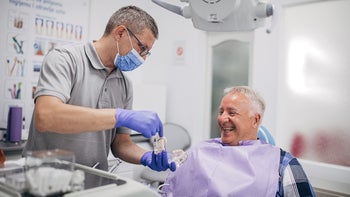Your Tooth Filling Fell Out: What to Do Before You See Your Dentist
Key takeaways:
In most cases, a loose or lost filling is not a dental emergency. But it’s important to contact your dentist promptly to get it evaluated and repaired.
To treat pain or sensitivity from a broken filling, try over-the-counter pain relievers, topical agents, and warm salt water rinses.
A broken filling can create a new space for food and bacteria to build up. To prevent further damage to your tooth, be sure to keep up your oral hygiene by brushing and flossing.

Many people have a tooth filling. And lots of people lose a filling at some point. But not everyone knows what to do with a lost or loose filling. We’ve got you covered with the next best steps to lessen the pain and keep your mouth healthy while you wait to see a dentist.
Is it an emergency if a filling falls out?
In most cases, a loose or lost filling is not a dental emergency. But it’s best to call your dentist as soon as possible. To avoid complications, try to schedule a visit within a few days.
But there are times a lost filling is a dental emergency, like if there’s:
Swelling around the tooth
Bleeding that won’t stop
Search and compare options
In these situations, call your dentist right away and tell them what’s happening. They can guide you on when and where to get emergency dental care.
What should you do if a filling falls out?
When a filling falls out of your tooth, it’s normal to feel worried. But try to stay calm. Here are three steps that you can take until you are able to get proper dental care.
1. Find the missing piece
First, try to find the loose piece. If you were eating when the filling broke, you may have accidentally swallowed the broken piece — that’s OK. The filling material is usually small enough that it won’t harm you if you swallow it.
If you find your broken filling, take it out of your mouth and throw it out. Chewing on broken filling material can cause further damage to your teeth.
2. Manage your pain
The missing filling material may expose the dentin — the second layer of your tooth. This layer includes nerve endings and can trigger pain.
If you’re in pain, here are a few tips to help:
Take an over-the-counter pain reliever, like ibuprofen (Advil) or acetaminophen (Tylenol) to reduce the pain.
Temporarily numb the area with a topical agent like Anbesol or Orajel.
Apply clove oil to the sensitive tooth and surrounding gums. The active ingredient, eugenol, will help reduce pain and inflammation.
Rinse with warm salt water. Mix ½ tsp of salt into a cup of warm water. Rinsing with warm salt water can help reduce pain and also prevent excess buildup of bacteria.
3. Keep your teeth as clean as possible
A broken filling means there's a new hole for food and bacteria to hide in. Keep the area as clean as possible to protect the tooth from further damage before you can get into the dentist to get it fixed.
A good oral hygiene routine includes brushing and flossing around the affected tooth twice a day. Rinsing with an antibacterial mouth rinse will protect the tooth even more. These simple things will help prevent any further decay on the exposed tooth.
What can cause a filling to come loose?
A filling usually lasts a long time. But this timing depends on how well you treat it on a day-to-day basis. However, fillings may fall out earlier than expected.
Here are several reasons why your filling may have come loose:
Hard and sticky foods: Biting into hard, sticky, or crunchy foods may put your filling at risk of breaking or coming loose. This is one of the most common causes of fillings coming out of a tooth.
New decay: Eating lots of acidic and sugary foods can cause new decay to form on your teeth, breaking down the adhesive barrier between your tooth and filling. This will loosen the filling over time.
Placement error: If a new filling comes out shortly after you get it placed, you may want to ask your dentist if the filling properly adhered to your tooth structure. Filling material needs a very dry environment to properly adhere when your dentist places it.
Do you have to pay for a new filling if it falls out?
The responsibility of paying for a new filling after it falls out depends on many factors. Here are some things your dentist will consider:
Did you recently get this filling placed?
Did the filling come loose due to a new cavity?
Did the dentist suggest a larger tooth repair and you opted for the less-expensive filling?
In most cases, the dentist or office manager will decide to reduce the rate of a new filling if it was recently placed. But you may be responsible for a small fee.
If a dentist finds that a new cavity is the source of the problem, you will most likely be responsible for the full cost of a new filling. Speak with the office manager about possible insurance coverage if you have dental insurance. You may have some sort of coverage with your current plan. And check out these ways to save money on dental care.
Is it OK to leave a broken filling?
A broken or lost filling can lead to many other issues if left alone for too long. A broken filling may expose the underlayer of your tooth, which is more vulnerable than the enamel (outside layer). This could lead to problems such as:
The formation of a new cavity
Loss of additional tooth structure
Extreme sensitivity to cold and hot drinks or food
Contact your dentist to schedule an appointment so that there’s no additional damage to your tooth. Keeping your teeth as healthy as possible is always going to be your dentist’s preference. And in the case of a broken or missing filling, this will very likely mean replacing the filling.
How to fix a broken filling without insurance
Dental work can be expensive whether or not you have insurance. But the costs of untreated problems can really add up.
If you don’t have dental insurance, check with your state or local health department to learn about programs near you that offer free or low-cost dental care. And read our article on how to manage dental costs without insurance.
The bottom line
A loose filling is not an emergency, but you should see a dentist to fix it. Opting not to repair it will lead to more damage in the long run. If you’re in pain, there are over-the-counter options to help bridge the gap until your dentist can fix your tooth. With prompt dental care, you will be back to pain-free smiling before you know it.
Why trust our experts?


References
Aravinth, V., et al. (2017). Comparative evaluation of salt water rinse with chlorhexidine against oral microbes: A school-based randomized controlled trial. Journal of the Indian Society of Pedodontics and Preventive Dentistry.
Haro-González, J. N., et al. (2021). Clove essential oil (Syzygium aromaticum L. Myrtaceae): Extraction, chemical composition, food applications, and essential bioactivity for human health. Molecules.
Kirsch, J., et al. (2016). Decision criteria for replacement of fillings: A retrospective study. Clinical and Experimental Dental Research.
Opdam, N. J., et al. (2014). Longevity of posterior composite restorations: A systematic review and meta-analysis. Journal of Dental Research.
Sahebalam, R., et al. (2018). Effect of the time of salivary contamination during light curing on degree of conversion and microhardness of a restorative composite resin. Biomimetics.
U.S. Department of Health and Human Services. (2023). Where can I find low-cost dental care?

























